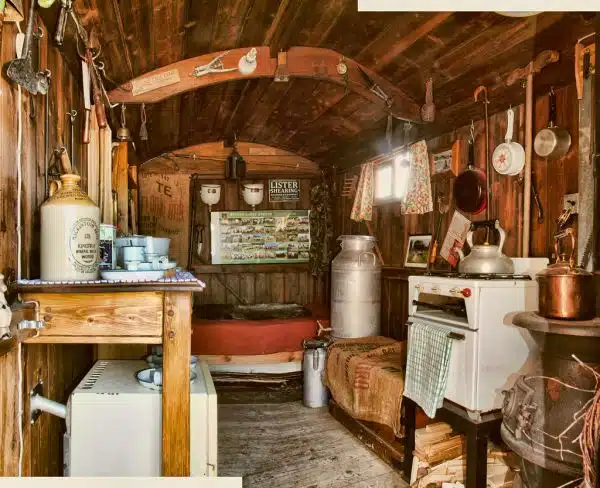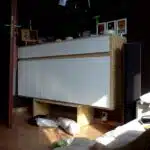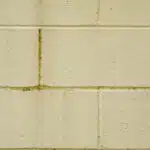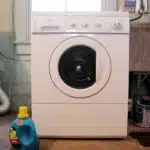Welcome to the world of refurbishing and personalizing old canisters. As an expert in this field, I have spent countless hours experimenting with different techniques to restore and customize these household essentials. Not only is refurbishing old canisters an environmentally friendly way to reuse and repurpose, but it also allows you to create unique and personalized storage solutions for your home.
In this article, we will cover various methods for reviving old canisters, as well as tips for adding a personal touch to make them truly your own. Whether you’re looking to store dry goods in the kitchen or organize your office supplies, there’s a canister out there waiting for you to give it new life. So let’s get started on transforming those neglected containers into functional and stylish additions to your home decor.
Assessing Your Canisters’ Condition
Let us assume that you have found a set of old canisters in your attic, and you want to refurbish and personalize them. The first step is to assess their condition. Start by determining the size of each canister. Smaller ones are perfect for holding spices or tea bags, while larger ones are suitable for storing flour or sugar.
After assessing the size of your canisters, find inspiration for how you want to refurbish them. Do you want a vintage look with distressed paint, or do you prefer something more modern with clean lines? You can browse online for ideas or visit local thrift stores to see how others have repurposed old containers.
Remember that the condition of your canisters will determine the amount of work needed to refurbish them. If they are rusted or dented, it may require more effort to restore them fully. However, don’t let this discourage you from taking on the project. With some patience and creativity, even the most damaged canisters can be transformed into something beautiful and functional.
Next up: Materials Needed for Refurbishing…
Materials Needed For Refurbishing
Assessing the current condition of your canisters is crucial before you start your DIY canister projects. Once you have evaluated them, it’s time to gather the necessary materials for refurbishing. Don’t worry, the materials needed are easy to find, and some of them might already be in your home.
To start with, you will need sandpaper with various grits, depending on how rough or smooth you want to make the surface of your canisters. You will also need a primer and paint that matches the color scheme or design that you want to use. Additionally, it would be best if you had brushes and rollers for painting and a sealant for finishing touches.
It’s always helpful to look for inspiration when personalizing your canisters. A quick online search or flipping through home decor magazines can give you plenty of ideas on how to transform your old canisters into something stylish and functional. Remember that this project is all about reflecting your personality and creativity, so don’t be afraid to experiment with colors, patterns, and textures.
Cleaning And Prepping Your Canisters
- Removing rust is an important step in preparing canisters for refurbishing, as it is necessary to remove all rust to ensure a smooth surface for painting and decorating.
- Sanding and priming the canister is a necessary step to prepare the surface for painting.
- Applying a coat of primer to the canister will provide a better surface for the paint to adhere to.
- Painting the canister is the most common way of personalizing it, but using stencils to decorate it is also a popular option.
- Decorating a canister with stencils is a great way to add a unique touch, as it allows for a wide range of designs and colours.
- Once the painting and decorating of the canister is complete, it is important to seal the surface with a protective sealant to ensure a long-lasting finish.
Removing Rust
If you’re like most people, you probably have a few old canisters lying around your home that could use some sprucing up. However, before you can start painting or decorating them, it’s important to first clean and prep the canisters properly. One of the biggest issues that many people face when refurbishing old canisters is dealing with rust. Fortunately, there are plenty of simple and effective ways to remove rust from your canisters.
Prevention is always the best approach when it comes to rust. If possible, store your canisters in a cool and dry place to minimize the risk of rust forming in the first place. Additionally, try not to expose your canisters to water or moisture for extended periods of time as this increases their likelihood of rusting. However, if rust has already formed on your canisters, there are several DIY rust removers that you can try.
One popular method involves mixing equal parts baking soda and water until they form a thick paste. Apply the paste onto the rusted areas of your canister and let it sit for at least an hour before scrubbing it off with a wire brush or scouring pad. Another option is to soak your canister in white vinegar for several hours or overnight before scrubbing away any remaining rust with a brush or pad. With these simple prevention tips and DIY remedies for removing rust, you’ll be able to easily clean and prep your old canisters for their new lease on life!
Sanding And Priming
To fully transform and personalize your old canisters, cleaning and prepping them is not enough. You also need to sand and prime them before choosing the paint that you will use. Sanding helps remove any remaining rust or paint, and it also creates a rough surface that allows the primer to adhere better. Meanwhile, applying primer serves as an additional layer of protection against rust and other forms of corrosion.
To start sanding your canisters, use a fine-grit sandpaper to gently rub the entire surface of each canister. Make sure that you remove any loose or chipping paint and rust spots in the process. After sanding, it is essential to wipe down each canister with a clean cloth to remove any dust or residue from the sandpaper.
Once your canisters are sanded thoroughly, you can apply a coat of primer using a brush or spray gun. Be sure to choose a primer that is suitable for metal surfaces and has anti-corrosive properties. Give ample time for the primer to dry before applying paint on top of it. By following these simple steps, you’ll be able to create beautifully refurbished canisters that are both functional and stylish!
Painting/Decorating
Now that you have cleaned, sanded, and primed your canisters, it’s time to move on to the fun part – painting and decorating! Painting techniques and color combinations are endless when it comes to refurbishing old canisters. You can choose a solid color for a classic look or experiment with different patterns and textures for a more unique style. Whatever your preference may be, here are some tips to guide you in painting and decorating your canisters.
First, choose the type of paint that is suitable for metal surfaces. You can use spray paint or brush-on paint depending on your comfort level. If you’re using spray paint, make sure to apply several thin coats instead of one thick layer to avoid drips and uneven coverage. For brush-on paint, use a high-quality brush to ensure smooth application without leaving brush marks. As for color combinations, you can mix and match colors that complement each other or go for bold contrasts that make a statement.
Finally, add some decorative elements such as stickers or stencils to give your canisters an extra touch of personality. You can also experiment with different finishes such as matte, glossy, or metallic for added texture and depth. With these tips in mind, you’ll be able to transform your old canisters into beautiful pieces that not only serve their purpose but also add aesthetic value to your home décor.
Sanding And Removing Old Paint
As you begin your canister refurbishing project, the first step is to remove any old paint or finish that may be present on the surface. It’s important to note that the process of removing old paint requires patience and careful attention to detail. Think of it like peeling an onion; you’ll need to remove one layer at a time until you get down to the base.
Choosing the right sandpaper grit is crucial for effectively removing old paint from your canisters. Start with a coarse grit, such as 60 or 80, and work your way up to finer grits like 120 or 150. Use a sanding block or sandpaper wrapped around a foam pad for even pressure and avoid leaving behind any rough spots. If you encounter tough spots that won’t budge with sandpaper alone, consider using a heat gun to soften the paint before continuing with sanding.
When it comes to removing old finishes from metal canisters, it’s essential to wear protective gloves and goggles. Use a chemical stripper designed for metal surfaces and follow the manufacturer’s instructions carefully. Once all traces of old finish have been removed, rinse thoroughly with water and dry completely before moving on to the next step in your project: choosing a new color scheme for your refurbished canisters.
Choosing A New Color Scheme
Choosing a New Color Scheme Choosing the right color scheme for your refurbished canisters is an important aspect of the personalization process. The colors you choose will set the tone and mood of your kitchen or pantry. When selecting paint, consider the overall theme and style of your home décor, as well as the desired feelings you want to evoke in the space. Additionally, keep in mind that different colors have different psychological effects on people.
Color psychology is the study of how colors affect human behavior and emotions. For example, red is known to increase appetite and stimulate energy levels, making it a popular choice for restaurant interiors. Blue, on the other hand, has calming properties and promotes relaxation, making it ideal for bedrooms and bathrooms. Yellow is associated with happiness and optimism, while green represents growth and balance. Understanding these principles can help you choose a color scheme that aligns with your personal style and enhances the functionality of your space.
When selecting paint for your canisters, opt for high-quality brands that offer a smooth finish and long-lasting durability. This ensures that your refurbished pieces will not only look great but also withstand daily wear and tear in the kitchen or pantry. In the next section, we will discuss painting techniques that can help you achieve a professional-looking finish on your canisters.
Painting Techniques For A Smooth Finish
When it comes to painting canisters, you have two options: spray or brush painting. Spray painting is ideal for covering large areas quickly and evenly, while brush painting allows for more precision and control. Both techniques require some practice to master, but once you get the hang of it, you’ll be able to achieve a smooth finish that looks professional.
Color blocking is a popular technique that involves using two or more contrasting colors to create a bold and graphic look. To do this, start by masking off the sections of the canister that you want to remain unpainted with painter’s tape. Then apply the base coat of paint in one color and let it dry completely before removing the tape. Next, apply another layer of tape over the painted section and paint the remaining area in another color. Repeat this process until you’ve achieved your desired design.
To ensure a smooth finish, it’s important to take your time and use thin layers of paint rather than one thick coat. This will prevent drips and ensure that each layer dries evenly before applying another. Additionally, always work in a well-ventilated area and wear protective gear such as gloves and a mask when working with spray paint. With these tips in mind, you’ll be able to achieve a flawless finish on your refurbished canisters using color blocking techniques.
Transitioning into adding decorative details: Once you’ve painted your canisters using your chosen technique, it’s time to add some decorative details to give them personality and style.
Adding Decorative Details
After achieving a smooth finish on your canisters, it’s time to add some decorative details to make them unique. Adding embellishments or using mixed media can give your old canisters new life and personality. There are many options for personalizing your canisters, and with a little creativity, you can turn them into one-of-a-kind pieces.
One way to add visual interest to your canisters is by adding embellishments. Embellishments such as beads, buttons, or rhinestones can be glued onto the surface of the canister. You could also try painting on designs or patterns using stencils or freehand techniques. Another option is decoupage, where you apply cut-out images from magazines or wrapping paper onto the surface of the canister using glue.
Using mixed media is another great way to personalize your canisters. This involves combining different materials such as fabric, paper, and paint to create a layered effect. For example, you could wrap a piece of fabric around the lid of the canister and secure it in place with glue. Then you could paint over it with acrylic paint for added texture and dimension. Experimenting with different materials and combinations will help you find what works best for your project.
When it comes to stenciling and lettering options, there are countless possibilities. Stenciling allows you to easily repeat a design or pattern on multiple surfaces for a cohesive look. Lettering options include using vinyl decals, hand-painting with stencils or freehand techniques, or even using adhesive letter stickers. Whatever method you choose, be sure to plan out your design beforehand so that it looks polished and intentional. With these tips in mind, you’re well on your way to creating custom-designed canisters that reflect your personal style!
Stenciling And Lettering Options
A canister’s appearance is crucial to its overall appeal, and stenciling or lettering is an excellent way to add a personal touch. Stencil designs and hand-painted options are two popular choices for refurbishing and personalizing old canisters. While stencil designs provide a uniform look, hand-painted options allow for greater flexibility in terms of creativity.
Stencil designs are available in various shapes, sizes, and themes, making them a versatile option for any canister. These designs are often pre-made and readily available at craft stores or online shops. Some popular stencil designs include flowers, animals, geometric patterns, and quotes. Using a stencil brush or sponge brush with acrylic paint is the easiest way to apply the stencil design onto the canister surface.
Hand-painted options offer more customizability as they allow you to create your own unique design. You may choose to paint your favorite quote or draw your favorite flower using acrylic paints suitable for ceramics or glass surfaces. If you’re not confident in free-hand painting, tracing your design on paper then transferring it onto the canister surface using transfer paper is recommended. Hand-painting requires patience and precision but allows for greater freedom in designing a personalized canister.
| Design Type | Pros | Cons |
|---|---|---|
| Stencil Designs | Uniform look; Various themes available; Easy application process | Limited customizability |
| Hand-Painted Options | More creative freedom; Unique design possible | Requires patience and precise brushwork; May require artistic ability |
To further personalize your revamped canisters, consider creating custom labels that reflect their contents. Labels help keep everything organized while adding flair to your space’s aesthetic. Creating custom labels is easy using label-making software or simply printing out labels on adhesive paper from your home printer. In the next section, we will discuss how to create compelling custom labels that take your refurbished canisters’ style up a notch.
Creating Custom Labels
Labeling your newly refurbished canisters is an essential step in personalizing them. Not only does it add a unique touch, but it also helps you identify the contents of each canister easily. There are several label design ideas you can consider, depending on your preference and style.
One popular labeling technique is to use chalkboard paint. This type of paint allows you to write and erase labels as needed, making it ideal for frequently changing contents. Alternatively, you can opt for vinyl labels, which come in various colors and designs. These labels are durable and long-lasting, making them perfect for everyday use.
When it comes to labeling tools and techniques, there are several options available. You can use stencils to create uniform lettering or freehand the labels using a permanent marker or paint pen. Another option is to use a label maker that prints out custom labels in different fonts and sizes. Whatever method you choose, make sure to clean the surface thoroughly before applying the labels to ensure they stick properly.
Label Design Ideas:
- Use colorful washi tape to create unique designs
- Print out vintage-style labels on adhesive paper
- Use metallic markers for a modern look
- Add stickers or decals for a fun twist
- Use themed designs based on the contents (e.g., coffee beans for coffee canisters)
With these label design ideas and labeling tools and techniques, you can personalize your refurbished canisters with ease. Adding custom labels not only adds visual appeal but also makes organizing your pantry more efficient. In the next section, we will explore how adding handles or knobs can further enhance your refurbished canisters’ functionality and aesthetic appeal.
Adding Handles Or Knobs
As a refurbishing and personalizing expert, it is my pleasure to share with you some tips on how to add handles or knobs to your old canisters. Not only will this give them a fresh new look, but it will also make them easier to handle. Don’t settle for plain and boring canisters when you can easily spruce them up with these DIY handle ideas.
Firstly, consider the size and shape of your canisters when deciding on the type of handle or knob to use. For larger canisters, handles that are wider and longer are more practical as they provide better grip. Meanwhile, smaller canisters require smaller handles or knobs that won’t overpower their size. Additionally, think about the placement of the handles or knobs – you want them to be at a comfortable height and position that is easy to reach.
There are many DIY handle ideas out there that you can try depending on your preference and skill level. You can repurpose old belts or leather straps, use rope or twine for a rustic look, or even mold your own handles using clay or resin. With these tips in mind, you’ll have no trouble adding a personalized touch to your canisters while also making them more functional. In the next section, we’ll move on to sealing and protecting your newly refurbished items so they last for years to come.
Sealing And Protecting Your Canisters
- To refurbish and personalize an old canister, begin by thoroughly cleaning the surface with a soft cloth and warm, soapy water.
- Next, apply a primer to the canister, which will help the paint adhere more effectively.
- Once the primer is dry, it is time to apply the paint of your choice.
- Carefully apply multiple coats of paint, allowing each coat to dry before continuing to the next layer.
- After the final coat of paint has been applied, apply a sealant to protect the paint and increase the longevity of the canister.
- To personalize the canister, use a variety of techniques such as stencils, decoupage, and spray paint to create unique designs.
- Finally, let the personalization and sealant dry completely before using the canister.
Cleaning
If you’re looking to refurbish and personalize old canisters, one of the most important steps is cleaning. Not only will cleaning ensure that your canisters look their best, but it will also help protect them from further damage. When it comes to cleaning your canisters, there are a variety of eco-friendly and natural solutions that you can use.
One great option for eco-friendly cleaning is vinegar. Simply mix equal parts water and vinegar in a spray bottle, then spray the solution onto your canisters and wipe them down with a soft cloth. Vinegar is not only effective at removing dirt and grime, but it is also a natural disinfectant. This means that not only will your canisters look great after being cleaned with vinegar, but they will also be free of harmful bacteria.
Another natural cleaning solution that works well for canisters is baking soda. To clean with baking soda, simply make a paste by mixing baking soda with water until it forms a thick consistency. Then, use a soft cloth or sponge to apply the paste to your canisters, rubbing gently in circular motions. Baking soda has abrasive properties that make it effective at removing stains and grime without damaging the surface of your canisters.
In conclusion, when refurbishing and personalizing old canisters, taking the time to properly clean them is crucial for both appearance and protection. Using eco-friendly and natural cleaning solutions such as vinegar or baking soda not only helps the environment but also ensures that your canisters are free of harmful chemicals while looking their best.
Priming
When it comes to refurbishing and personalizing old canisters, one important step in the process is sealing and protecting them. This not only helps to maintain their appearance but also ensures that they are durable and long-lasting. One effective way to protect your canisters is by using primer.
Using primer before painting or coating your canisters provides several benefits. Priming helps to improve adhesion, meaning that whatever you apply on top of the primer will stick better and last longer. Additionally, priming creates a barrier between the surface of your canisters and any materials applied on top, preventing damage caused by moisture or other factors.
To use primer for your canister refurbishing project, start by cleaning your canisters thoroughly with an eco-friendly solution such as vinegar or baking soda. Once dry, apply a thin layer of primer evenly over the surface of your canisters, using a brush or roller as needed. Allow the primer to dry completely before applying any additional coatings or paints.
In summary, using primer is a crucial step in sealing and protecting your canisters during refurbishing. The benefits of priming include improved adhesion and protection against damage from moisture or other factors. By following proper procedures for priming, you’ll be able to ensure that your refurbished canisters are both visually appealing and long-lasting.
Painting
After successfully applying primer to your canisters, the next step in refurbishing and personalizing them is painting. Painting your canisters not only adds color but also provides additional protection against wear and tear. When it comes to painting your canisters, there are several factors to consider, including color combinations and brush techniques.
Choosing the right color combination for your canisters is important in achieving the desired aesthetic. You can either choose a single color or mix and match different colors depending on your preference. It’s essential to ensure that the colors you choose complement each other and blend well with your overall décor.
When it comes to brush techniques, using the right brush size and technique will help you achieve a smooth finish without leaving visible brushstrokes. Using a smaller brush for detailed areas and a larger one for broader surfaces will enable you to paint efficiently with minimal mistakes. Additionally, using thin layers of paint will prevent dripping or clumping while ensuring that the paint dries evenly.
Overall, painting is an essential step in sealing and protecting your canisters while adding personality to them. By choosing the right color combination and employing proper brush techniques, you’ll be able to create beautifully painted canisters that are both visually appealing and long-lasting.
Styling Your Canisters In Your Home
Canisters as Home Decor are an excellent way to add a personal touch to your living space. They come in various shapes, sizes, and materials that make them ideal for customizing and styling according to your preference. These versatile containers can be used in several ways that not only serve functional purposes but also enhance the aesthetic appeal of your home.
DIY Canister Projects are an effective way to refurbish old canisters and transform them into decorative pieces. With some simple tools, materials, and creativity, you can give your canisters a new lease on life and add unique charm to your interiors. Some popular DIY ideas include painting or decoupaging the exterior with colorful patterns or designs, adding labels or tags for easy identification, or attaching decorative knobs or handles for a more vintage look.
Incorporating Canisters as Home Decor is a budget-friendly way to spruce up your living space without breaking the bank. You can use them to store kitchen essentials like sugar, flour, or spices in the pantry or display them on open shelves for a rustic touch. Additionally, they make great centerpieces when filled with flowers or greenery that adds freshness and vitality to any room. With their versatility and customization options, Canisters as Home Decor is an excellent choice for anyone looking to personalize their home decor.
As we have seen above, Canisters as Home Decor offer a plethora of creative possibilities that allow you to style and customize according to your taste. However, if you’re looking for other ways to repurpose old canisters besides using them as home decor items, there are several other ideas worth exploring.
Repurposing Canisters For Alternate Uses
Now that you have styled your canisters to fit your home decor, it is time to explore the many uses for repurposed canisters. These versatile containers can be used in a variety of ways beyond their original purpose. With a little creativity and imagination, you can turn old canisters into functional and decorative objects.
One great way to repurpose canisters is by using them as storage containers for small items such as office supplies, craft materials, or even snacks. By adding labels or tags to the canisters, you can easily identify what is inside and keep everything organized. Another idea is to use them as planters for small flowers or herbs. Simply drill some drainage holes in the bottom of the canister and add soil and seeds. Not only will this give new life to your old canisters, but it will also add a touch of greenery to your space.
If you are feeling particularly creative, there are countless design options for upcycled canisters. You could paint them with fun patterns or colors, decoupage them with pictures or newspaper clippings, or even add embellishments such as beads or ribbons. The possibilities are endless when it comes to personalizing your repurposed canisters. Not only will this make them unique and one-of-a-kind, but it will also showcase your personality and style.
To take your upcycling ideas for extra creativity, consider turning several different sized canisters into a tiered display stand for cupcakes or other treats at your next party. Or create a DIY lamp by drilling holes in the sides of a large metal canister and threading string lights through them. The key is to think outside of the box when it comes to repurposing old cans and jars. With a little effort and imagination, you’ll be amazed at what you can create!
Upcycling Ideas For Extra Creativity
Paint techniques can be used to upcycle old canisters and give them an updated look. Decoupage is another popular method of upcycling canisters and adding a personal touch. It is important to use high quality paints and sealants to ensure the longevity of the paint job. Use of decoupage mediums can provide intricate designs and also ensure the longevity of the design.
Paint Techniques
With an eye for detail and a passion for upcycling, there are numerous paint techniques that can be used to give old canisters a new lease on life. Distressing techniques, for example, can create the illusion of aged or weathered metal. This method involves applying dark paint over the base color and then rubbing it off in selected areas with sandpaper or a rough cloth. The result is a worn-out look that adds character to any container.
Color blocking ideas are also popular when it comes to refurbishing old canisters. This technique involves dividing the container into two or more sections and painting each section with different colors. The key to achieving this look is to ensure that the colors complement each other and do not clash. Using painter’s tape to create clean lines between the colors is essential for a professional finish.
In summary, with some imagination and creativity, there are many ways to personalize old canisters using various paint techniques such as distressing and color blocking. These methods add personality and individuality to any room while also helping to minimize waste by repurposing items that would otherwise end up in landfills. Whether you’re looking for a rustic or modern look, these techniques offer endless possibilities for refurbishing old containers into beautiful works of art.
Decoupage Methods
As a refurbishing and personalizing expert, there are many paint techniques that can be used to upcycle old canisters. However, for those who want to take their creativity to the next level, decoupage methods are an excellent option. This technique involves adhering paper or fabric onto surfaces using glue or a decoupage medium. Vintage imagery and unique patterns can be used to create one-of-a-kind pieces that add character to any room.
Incorporating personal photos is another way to make your decoupaged canisters even more special. Family portraits, travel snapshots, or even images from magazines can be cut out and applied onto the surface of the container. This not only adds a personal touch but also provides an opportunity to preserve cherished memories in a unique way.
Overall, decoupage methods offer endless possibilities for those looking to add extra creativity to their upcycling projects. Whether it’s using vintage imagery or incorporating personal photos, this technique allows you to create beautiful works of art that are both functional and sentimental. So go ahead and try your hand at this fun and rewarding craft!
Maintaining Your Newly Refurbished Canisters
After refurbishing and personalizing your old canisters, it’s important to maintain their new appearance. One way to do this is by regularly cleaning them. Simply wiping down the canisters with a damp cloth will help remove any dust or dirt that may accumulate on them over time.
Another great way to maintain your newly refurbished canisters is by decorating with them. Not only do they add an element of style to any space, but they also serve a practical purpose. Use them to store items such as flour, sugar, or coffee beans in the kitchen, or cotton balls and q-tips in the bathroom.
Lastly, consider some organization tips when maintaining your refurbished canisters. Labeling them with their contents will not only make it easier for you to find what you need but will also prevent confusion when others are looking for something. Additionally, storing similar items together in one canister will help keep things tidy and easy to find.
By following these simple maintenance steps, your newly refurbished canisters will continue to look great while serving their practical purpose in your home. With a little care and attention, they’ll become a staple piece that you’ll be proud to display!
Conclusion
Assessing the condition of your old canisters is the first step in refurbishing and personalizing them. Once you have determined the state of your canisters, gather the necessary materials such as sandpaper, primer, and paint to begin refurbishing. Proper cleaning and prepping is crucial to ensure a smooth surface for painting.
Sanding and removing old paint can be a tedious process but it is important to create a clean canvas for your new color scheme. Choosing a new color scheme that fits your personal style will add personality to your refurbished canisters. After styling them in your home, consider repurposing them for alternate uses or incorporating upcycling ideas for extra creativity.
Did you know that in 2019, 91% of consumers would prefer to purchase products that are environmentally friendly? By refurbishing and personalizing old canisters instead of purchasing new ones, you are not only saving money but also contributing to sustainable practices. Refurbishing old items not only adds character to your home but also helps reduce waste in our environment. So why not try refurbishing and personalizing your own old canisters today?
Image Credits
- “The interior of a restored shepherd’s hut” by Anguskirk (featured)





























